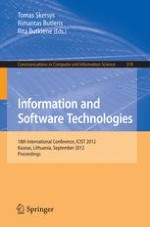This book constitutes the refereed proceedings of the 18th International Conference on Information and Software Technologies, ICIST 2012, held in Kaunas, Lithuania, in September 2012. The 40 revised full papers presented were carefully reviewed and selected from 81 submissions. The papers are organized in topical sections on artificial intelligence and knowledge engineering, business process modelling, analysis and design, formal analysis and design methods, information and software systems engineering, information technology applications and computer networks, information technology in teaching and learning, ontology, conceptual modelling and databases, requirements engineering and business rules.
